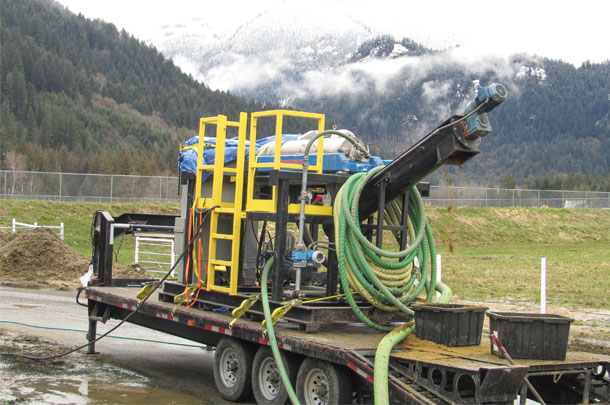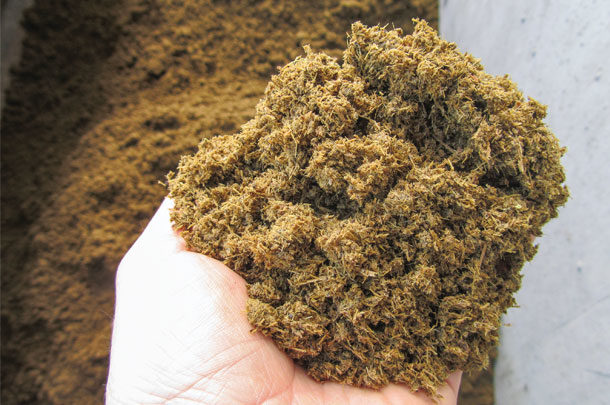The reason for this buildup is: Phosphorus is imported onto dairy farms in the province in the form of feedstuffs and fertilizers, while a smaller amount of phosphorus is exported off farms in the form of milk. This imbalance increases if dairy herd sizes increase without an equivalent increase in farmland on which to spread dairy manure.
Due to this phosphorus buildup in some soils, some dairy farmers require an alternative to the current land application of dairy manure. This need is potentially becoming more urgent due to increased discussion concerning development of new regulations for agricultural waste.
A centrifuge was tested on seven dairy farms to assess how much phosphorus can be extracted from dairy manure.

This project was funded and supported by the BC Dairy Association, BC Agriculture Council, seven participating dairy farmers and by the governments of Canada and British Columbia through programs delivered by the Investment Agriculture Foundation of British Columbia.
Centrifuges are capable of extracting phosphorus from dairy manure because most of the phosphorus in manure is bound to small solids.
By using high speeds to create centrifugal force, centrifuges separate solids from liquids, extracting phosphorus from dairy manure into a solid product. This solid product, with dry matter of approximately 25 percent, is easier and cheaper to transport off the farm than dairy manure.
Used widely in a large number of industries to separate solids from liquids, from oil and gas to food and beverage processing, centrifuges are now being used on dairy and hog farms in Europe and the U.S. Until now, testing on British Columbia dairy farms has been limited.
To fill this knowledge gap, a centrifuge was tested on seven dairy farms in the Fraser Valley. Six of these farms have scrape manure collection, while one farm has flush manure collection.
On the six scrape manure collection farms, phosphorus extraction of 50 to 60 percent was consistently achieved, while highest extraction achieved on any one farm was 75 percent. For the flush manure collection farm, phosphorus extraction of 40 to 50 percent was consistently achieved.
During phosphorus extraction, some nitrogen and potassium are also extracted. While this isn’t ideal for most British Columbia dairy farms, as nitrogen is often the limiting nutrient for most crops, this is simply a reality of the technology.
“These results clearly show centrifuges can be used to extract a high percentage of phosphorus from dairy manure,” explained project manager Matt Dickson, Hallbar Consulting. “Furthermore, because the results were consistent across all seven farms, we are confident they can be achieved on almost every BC dairy farm.”
“Perhaps more interesting and relevant,” according to Environmental Farm Plan adviser and project co-ordinator Dave Melnychuk, “is that, based on the test results, if all seven participating dairy farmers were to use a centrifuge and transport the high-phosphorous solid product off their farms, they could expand their herd size by at least 15 percent and still be able to meet the requirements of a nutrient management plan, even without purchasing or renting additional land. As more quota is issued, herd sizes increase and land prices continue to rise, centrifuge technology starts to look promising.”
Unfortunately, the solid product produced by a centrifuge doesn’t seem to have much value, especially in the Fraser Valley. As such, Dickson cautions, “Centrifuges rarely pay for themselves. Instead, they should be seen as a cost of doing business.”
“Due to the availability of many other sources of organic matter, such as poultry litter and spent mushroom compost, it looks like most BC dairy farmers may have to give the solid product away or somehow transport it outside of the Fraser Valley,” Dickson explains. “However, the economic feasibility of transporting the solid product over long distances is currently unknown and, therefore, more work is required before farmers should consider this option.”
While required next steps for technology adoption are still under discussion, this is exactly the type of work the province’s dairy sector supports. “The BC Dairy Association is always looking at ways to ensure dairy farming delivers a positive impact on our community,” explains Holger Schwichtenberg, Mainland Milk Producer chairman. “This is why we chose to support this study through the Dairy Industry Research and Education Committee.” ![]()
PHOTO 1: Centrifuges are capable of extracting phosphorus from dairy manure because most of the phosphorus in manure is bound to small solids. The nutrient component of the solid manure particles can then be managed separately or potentially sold off the farm.
PHOTO 2: A centrifuge was tested on seven dairy farms in British Columbia to assess how much phosphorus can be extracted from dairy manure. Photos courtesy of Hallbar Consulting Inc.









